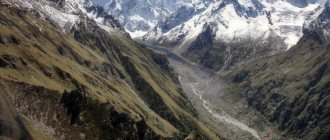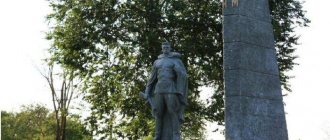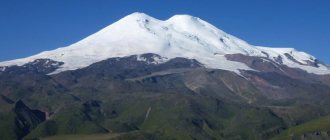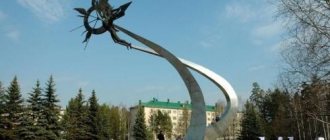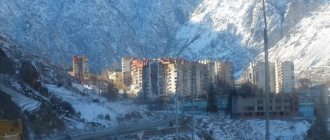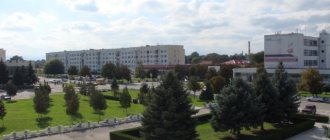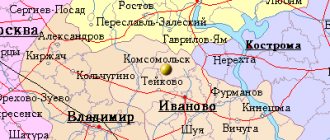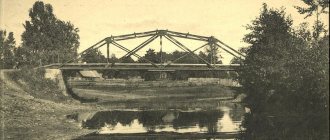This term has other meanings, see Baksan.
This article is about the city.
For the urban district, see Baksan Urban District. Coat of arms
| City | |
| Baksan | |
| Kabard.-Cherk. Bakhsen | |
until 1960 -
Old FortressCity since 1967Area 27.79[1] km²Height of center455 mClimate typehumid temperate (Dfb)Time zoneUTC+3:00PopulationPopulation↗38,645[2] people (2021)Density1390.61 people/km²Agglomeration↗59,192[3] people (2018)Nationalities sy , Russian Confessions Sunni Muslims, Orthodox Katoykonimbaksans, Baksan, Baksanka Official language Kabardian, Balkar, Russian Digital identifiers Telephone +7 86634 Postal codes 361 530 — 361 535 OKATO83403000000 OKTMO8370300000 1OtherCity DaySeptember 1 / September 20Precipitation norm600-700 / year Baksan
Moscow
Nalchik
Baksan
Media files on Wikimedia CommonsBaksan
(Kabard-Cherk. Bakhsen) is a city of republican significance in the Kabardino-Balkarian Republic.
Administrative center of the municipalities Baksan Urban Okrug and Baksansky District ( which does not include
).
Geography[ | ]
View of Elbrus from the city park
The city is located in the northern part of the republic, on the left bank of the Baksan River, at its exit from the gorge onto the foothill plain. Located 18 km ( as the crow flies)
) north of the republican center of the city of Nalchik.
The federal highway “Caucasus” P-217 runs along the western outskirts of the city, and its bypass route passes through the city center. The federal highway “Prokhladny-Baksan-Elbrus” A-158 runs along the southern outskirts, leading to the Elbrus region.
| Distance from Baksan to major cities (by road)[5] | ||||
| NW | Stavropol ~ 260 km Pyatigorsk ~ 60 km | Budennovsk ~ 190 km Novopavlovsk ~ 60 km | Neftekumsk ~ 260 km Astrakhan ~ 600 km | NE |
| Z | Kislovodsk ~ 100 km Cherkessk ~ 150 km | Prokhladny ~ 35 km Mozdok ~ 120 km | IN | |
| S-W | Tyrnyauz ~ 65 km Sochi ~ 620 km | Chegem ~ 15 km Nalchik ~ 20 km | Terek ~ 75 km Vladikavkaz ~ 130 km | SE |
The area occupied by the city is 27.79 km2.
It borders on the lands of settlements: Dygulybgey in the south, Islamey in the southwest, Psychokh in the north, Baksanyonok in the east and Kishpek in the southeast.
The city is located in the foothills zone of the republic. Average altitudes are about 455 meters above sea level. The terrain is mainly foothill sloping plains, characterized by a gentle slope of the terrace to the east, in the form of wide hollows and gently sloping slopes. To the southwest of the city rises the Mahogaps mountain range. The subsoil of the city is composed of a thick layer of alluvial boulder-pebble rocks, with sandy filling of the ground water located at a depth of 17-20 meters.
The hydrographic network is represented, first of all, by the Baksan River and its channels (Geduko, Novaya Nakhalovka Canal, Baksanenok). In the surrounding area there is a network of canals that ensure the flow of water from Baksan to the north, to Malka. The largest of them, Baksan-Malkinsky, stretches to the east of the city. To the northeast of the city of Baksan, two watercourses flow from it, already belonging to the Malka basin - Sukhaya Psarysha and Wet Psarysha. The Novaya Nakhalovka Canal, which also feeds the Baksanenok River, also in fact originates from the Baksan-Malkinsky Canal, and not from the Baksan River itself. To the northwest and north of the city are the Nevolka and Khatakumsky canals, originating from Baksan upstream. The Hatakum Canal is named after the small drying Hatakum stream flowing from it; subsequently it connects with the Baksan-Malkinsky Canal. The Nevolka Canal carries out the flow from Baksan to Kurkuzhin.
The climate is humid and temperate with warm summers and cool winters. The average annual air temperature is about +9.5°C, and ranges from an average of +21.5°C in July to an average of −3.0°C in January. The average daily air temperature ranges from −10.0°C to +15.0°C in winter, and from +16.0°C to +30.0°C in summer. The average annual precipitation is about 650 mm. In spring, when there are sharp changes in temperature, strong winds blow from the mountains. The predominant wind direction is southwest.
How everything turned into scrap
Spouse Elena
and
Sergei
came to work at the plant in the early 1990s and witnessed its gradual decline.
– I worked on the Euclid mining dump truck. The wheel diameter is 3.6 meters, the machine weighs 155 tons. In fact, it is easier to drive than a Lada (Laughs. - τ.). Came to Tyrnyauz in 1989. By this time, my mother and brother had already moved here. He also worked in a quarry. At first I was a mechanic, then after an internship I switched from 1991 to a heavy truck driver. The work was hard, but interesting. We had 15 Euclids, about 30 120-ton BelAZs, 16 excavators. When I was a mechanic, the salary reached 450 rubles, then by car - up to 700 rubles. And most importantly, there was respect for ordinary hard workers,” shares Sergei.
Elena says that the history of her entire family is connected with the plant:
– My grandfather was the first to come here, then there was still the village of Nizhny Baksan. Mom graduated from school here. My father worked in a mine, then in a repair and construction shop. Everyone was provided with housing - first a hostel, communal apartments, and then their own. There were many young engineers. Everyone received an education, many by correspondence from the plant. I also went to study at the Mining Institute and returned here in 1991. The plant was rich, with excellent food supplies, and they also gave vacation vouchers.
In the early 1990s there was no sense that there would be problems. There were good salaries and career growth. However, then everything changed dramatically. Wages began to be delayed. Elena left the plant in 1995, Sergei worked until the end.
His former colleague Victor
, who has been making money as a private driver since the early 2000s, told Octagon that in February 1995, his team received an order to drive away the excavators and lay the cars down.
– By June, there were only three cars and three excavators left. Organizational changes began, corporatization began, and assets began to be divided. Managers changed, equipment was removed. There is only one road here, so it was clearly visible how everything was transported along Elbrus Avenue.
“In fact, the new equipment was cut into scrap metal. The engines were removed from the cars, everything that could be sold, the rest was used for scrap. Separate brigades were created for this purpose. They sold scrap metal for 200–250 rubles per ton. Almost new excavators also cut, as did machine tools. Why? It’s clear, because you can sell a whole excavator only for cashless payments...”
According to residents, the whole city saw, knew and still knows who was organizing the cutting and sale. However, no one was punished. This fact from the biography of the plant simply remained a fact. “After the plant shut down in 2001, all industrial buildings and structures were destroyed, and metal parts were scrapped,” says the materials of Giprotsvetmet JSC, dedicated to the prospects for restoring the plant.
History[ | ]
Southern entrance to the city On Revolyutsionnaya Street
In 1822, opposite the village of Kuchmazukino (Kabard-Cherk. Kushmezykuey), a Russian military settlement was founded, which was part of the Caucasian military line.
In 1825, after the annexation of Kabarda to the Russian Empire, the population of the village of Kuchmazukino, not wanting to recognize the power of the tsarist administration over themselves, moved beyond the Kuban in order to continue the war there with other Circassians.
After the end of the Caucasian War, in 1867, the residents of the village of Kuchmazukino moved back to Kabarda and settled east of the military fortification, to their former place.
In 1891, to the west of the military fortification, immigrants from the Central ( mainly from the Kursk
) provinces of the Russian Empire, the Baksan farmstead was founded.
In 1920, with the final establishment of Soviet power in Kabarda, by the decision of the Revolutionary Committee of the Nalchik District, Kuchmazukino, like other Kabardian settlements, was renamed due to the presence of princely and noble families in their names. As a result, the village received a new name - Old Fortress.
During the Great Patriotic War, the village and hamlet were occupied by German troops in October 1942. Released in early January 1943. In memory of the fallen soldiers, several monuments have been erected in the city.
In 1960, the village of Old Fortress ( about 8,000 inhabitants in 1959
) and the village of Baksan (
3,583 inhabitants in 1959
) were merged into the village of Baksan.
In 1964, the village was given the status of an urban-type settlement.
In 1967, the urban-type settlement was given city status.
In 2003, the village of Dugulubgey was included in the city. After which, on August 8, 2003, Baksan received the status of a city of republican subordination and was transformed into the Baksan urban district.
In 2008, Dygulybgey was separated back from the city, with the status of a village being returned to it, as part of the Baksan urban district.
Administrative and municipal status[edit]
As part of the administrative divisions, Baksan serves as the administrative center of Baksan District, even though it is not part of it. [1] As an administrative division, that is, together with one rural area (The village
of Dygulybgey), incorporated separately as
a city of republican significance, Baksan
—an administrative unit with status equal to that of the districts.
[1] As a municipal division, the city of republican significance of Baksan is included as the Baksan urban district
. [5]
Population[ | ]
| Population | |||||||||
| 1939[6] | 1959[7] | 1970[8] | 1979[9] | 1989[10] | 1992[11] | 1996[11] | 2000[11] | 2002[12] | 2003[11] |
| 3805 | ↘3583 | ↗18 443 | ↗21 843 | ↗28 767 | ↗30 200 | ↗31 400 | ↗32 200 | ↗35 805 | ↘35 800 |
| 2005[11] | 2006[11] | 2007[11] | 2008[11] | 2009[13] | 2010[14] | 2011[11] | 2012[15] | 2013[16] | 2014[17] |
| ↗56 900 | ↗57 000 | ↗57 400 | ↗57 800 | ↘37 346 | ↘36 860 | ↗36 900 | ↗36 907 | ↗37 163 | ↗37 373 |
| 2015[18] | 2016[19] | 2017[20] | 2018[21] | 2019[22] | 2020[3] | 2021[2] | |||
| ↗37 527 | ↗37 782 | ↗38 053 | ↗38 192 | ↗38 361 | ↗38 474 | ↗38 645 | |||
As of January 1, 2022, in terms of population, the city was in 399th place out of 1,116[23]cities of the Russian Federation[24].
Density - 1390.61 people/km2.
National composition
According to the 2010 All-Russian Population Census[25]:
| People | Number of people, people | Share of the total population, % |
| Circassians (Kabardians) | 33 226 | 90,1 % |
| Russians | 2 770 | 7,5 % |
| other | 864 | 2,3 % |
| Total | 36 860 | 100,0 % |
Sex and age composition of the population
According to the 2010 All-Russian Population Census[26]:
| Age | Men, persons | Women, persons | Total number, people | Share of the total population, % |
| 0 – 14 years | 4 383 | 3 923 | 8 306 | 22,5 % |
| 15 – 59 years | 11 584 | 12 740 | 24 324 | 66,0 % |
| from 60 years old | 1 629 | 2 601 | 4 230 | 11,5 % |
| Total | 17 596 | 19 624 | 36 860 | 100,0 % |
Men - 17,596 people. (47.7%). Women - 19,264 people. (52.3%)[27].
The average age of the population is 33.2 years. The median age of the population is 30.8 years.
The average age of men is 31.4 years. The median age of men is 29.1 years.
The average age of women is 34.8 years. The median age of women is 32.7 years.
Education[ | ]
In the courtyard of school No. 2 Municipal educational institutions in the city
| Educational institution | Type of institution | Address |
| MKOU Progymnasium No. 1 | initial | st. Ugnich, 8. |
| MKOU Progymnasium No. 2 | initial | Revolyutsionnaya st., b/n. |
| MKOU Progymnasium No. 3 | initial | st. Budyonny, 93. |
| MKOU Progymnasium No. 4 | initial | st. Lenina, 92 "a". |
| MKOU Progymnasium No. 5 | initial | st. Lenina, 128. |
| MKOU secondary school No. 1 named after. Pashtova S. A. | average | st. Lenina, 86. |
| MKOU secondary school No. 2 named after. Shogentsukova A. A. | average | st. Beslaneeva, 7. |
| MKOU secondary school No. 3 named after. Kalmykova R. A. | average | st. Kalmykova, 1. |
| MKOU secondary school No. 4 named after. Sizhazheva M. A. | average | st. Panayoti, 177. |
| MKOU secondary school No. 5 named after. Nagoeva N. I. | average | st. Shukova, 98. |
| MKOU secondary school No. 6 | average | st. Ugnich, 1. |
There are also 4 preschool institutions, 5 additional education institutions and 3 sports education institutions in the city.
Economics[ | ]
Baksan is an industrially developing city[31]. At the beginning of 2012, more than 423 enterprises of all forms of ownership in the manufacturing sectors operated in the urban district.
Among the large enterprises of the city, there are 12 in the industrial sector, 7 in the construction sector, 4 in the transport and communications sector, and 3 in the agro-industrial complex.
The main budget-generating enterprises are Avtozapchast, Intervain, Victoria-N and Backstrom, which account for more than 70% of the total production of industrial goods.
In November 2016, the construction of the first stage of the Textile Industry LLC textile factory was completed in the city.
The men left, the women sat down to knit.
– When there was no more work on the machines, we were just on duty. The analysis went on both day and night. They continued to feed us breakfast that work would resume soon. There were rumors that the plant would be bought by Deripaska
, but that didn't happen. And the remaining metal is still being exported,” says Victor.
People survived in different ways back then. A store was opened in the city for the plant’s employees, selling basic necessities and a minimum set of products. Some of the population saved themselves by their vegetable gardens, some by keeping livestock. The women knitted.
– I knitted a lot so that I could go to the market and sell it on the weekend. Speculators from Goryachevodsk came to us and took our handicrafts somewhere. Many women's eyesight was severely damaged then. And after the mudflow, many began to complain about pain in their legs and joints. Perhaps this is due to the fact that the lake into which the plant was discharging process water overflowed. The men went on shifts: some to Sochi, some to Krasnaya Polyana, some to Magadan. Some went to Mongolia on contracts, and after they earned money there, they bought housing in other regions. Of those who were visitors to Tyrnyauz, everyone went home. These were mainly valuable personnel, engineers,” says Marina.
According to former employees, they do not receive any compensation or additional payments to their pensions. Almost everyone has already reached retirement age, but is forced to work part-time because the state pays them no more than ordinary pensioners throughout Russia.
Famous natives[ | ]
People born in Baksan:
- Shogentsukov Ali Askhadovich - poet, writer, founder of modern Kabardian literature.
- Shogentsukov Adam Ogurlievich is a Kabardian poet, prose writer, playwright and publicist.
- Dymov Adam Gafarovich is the founder of the first national printing house and publisher of the first circulated newspaper in the Kabardian language.
- Levchenko Vasily Sidorovich - Hero of the Soviet Union.
- Tutov Zaur Nazhidovich - People's Artist of the Russian Federation and the republics of the KBR, KCHR and Adygea. Minister of Culture of the KBR.
- Mudranov Beslan Zaudinovich - Olympic champion in judo at the 2016 Rio de Janeiro Games.
- Goshokov Arsen Aslanovich is a football player, forward of the Spartak-Nalchik club.
- Bifov Anatoly Zhamalovich - deputy of the State Duma of the Federal Assembly of the Russian Federation of the VI and VII convocations.
Notes[ | ]
- General plan of the Baksan urban district
- ↑ 12
The permanent population of the Russian Federation by municipalities as of January 1, 2022 (Russian). Retrieved April 27, 2022. Archived May 2, 2022. - ↑ 12
Population of the Russian Federation by municipalities as of January 1, 2022 (Russian). Date accessed: October 17, 2022. Archived October 17, 2022. - Pospelov, 2008, p. 93.
- Calculation of distances between cities (undefined)
(inaccessible link). Archived June 23, 2010. - Baksan district 1939
- All-Union Population Census of 1959. Number of rural population of the RSFSR - residents of rural settlements - district centers by gender
- All-Union Population Census of 1970 The size of the urban population of the RSFSR, its territorial units, urban settlements and urban areas by gender. (Russian). Demoscope Weekly. Access date: September 25, 2013. Archived April 28, 2013.
- All-Union Population Census of 1979 The size of the urban population of the RSFSR, its territorial units, urban settlements and urban areas by gender. (Russian). Demoscope Weekly. Access date: September 25, 2013. Archived April 28, 2013.
- All-Union population census of 1989. Urban population (undefined)
. Archived from the original on August 22, 2011. - ↑ 123456789
People's encyclopedia "My City". Baksan (city) - All-Russian population census 2002. Volume. 1, table 4. Population of Russia, federal districts, constituent entities of the Russian Federation, districts, urban settlements, rural settlements - regional centers and rural settlements with a population of 3 thousand or more (unspecified)
. Archived from the original on February 3, 2012. - The size of the permanent population of the Russian Federation by cities, urban-type settlements and regions as of January 1, 2009 (unspecified)
. Retrieved January 2, 2014. Archived January 2, 2014. - Population of the Kabardino-Balkarian Republic by settlement according to the results of the 2010 All-Russian Population Census (unspecified)
(inaccessible link). Access date: September 21, 2014. Archived January 2, 2014. - Population of the Russian Federation by municipalities. Table 35. Estimated resident population as of January 1, 2012 (unspecified)
. Retrieved May 31, 2014. Archived May 31, 2014. - Population of the Russian Federation by municipalities as of January 1, 2013. - M.: Federal State Statistics Service Rosstat, 2013. - 528 p. (Table 33. Population of urban districts, municipal districts, urban and rural settlements, urban settlements, rural settlements) (undefined)
. Retrieved November 16, 2013. Archived November 16, 2013. - Table 33. Population of the Russian Federation by municipalities as of January 1, 2014 (unspecified)
. Access date: August 2, 2014. Archived August 2, 2014. - Population of the Russian Federation by municipalities as of January 1, 2015 (unspecified)
. Access date: August 6, 2015. Archived August 6, 2015. - Population of the Russian Federation by municipalities as of January 1, 2016 (Russian) (October 5, 2018). Retrieved May 15, 2022. Archived May 8, 2022.
- Population of the Russian Federation by municipalities as of January 1, 2022 (Russian) (July 31, 2017). Retrieved July 31, 2022. Archived July 31, 2022.
- Population of the Russian Federation by municipalities as of January 1, 2022 (Russian). Retrieved July 25, 2018. Archived July 26, 2022.
- Population of the Russian Federation by municipalities as of January 1, 2022 (Russian). Retrieved July 31, 2019. Archived May 2, 2022.
- taking into account the cities of Crimea
- https://rosstat.gov.ru/storage/mediabank/bul_Chislen_nasel_MO-01-01-2021.rar Population of the Russian Federation by municipalities as of January 1, 2022 (1.85 Mb, 07/30/2021)
- Volume 3. Table 4. Population by nationality and Russian language proficiency by municipalities and settlements of the KBR (undefined)
(inaccessible link). Date accessed: July 18, 2022. Archived March 6, 2016. - Volume 1. Table 2.2 Population of the CBD by age groups and gender (unspecified)
(inaccessible link). Date accessed: July 18, 2022. Archived October 1, 2022. - Population of the KBR according to the results of the 2010 All-Russian Population Census (unspecified)
(inaccessible link). Retrieved June 12, 2016. Archived June 24, 2016. - Religion. Baksan urban district (undefined)
. - Baksan Urban District: Healthcare (unspecified)
. - Newspaper "Baksan" (undefined)
. - Economy of the city of Baksan (undefined)
. - s OKATO and OKTMO - Baksan (unspecified)
(inaccessible link). Retrieved March 23, 2022. Archived September 24, 2015.
Rostec project: construction has not started
At the end of December 2022, Rosnedra announced a tender for the purchase of a license to resume production at the Tyrnyauz field. In May 2018, the right to develop it was received by the only participant in the competition - the structure of the Rostec state corporation, Elbrus Mining Plant LLC (EGRC). In June 2022, the Rostec board approved the project implementation plan. According to it, design and survey work should be carried out in 2019–2021, and construction and launch of the enterprise in 2021–2023. The start of work is planned for this year, the start of production is for 2023.
According to the schedule (available to the editors), 100 thousand tons of ore should be mined in 2023, 500 thousand in 2024, 1 million in 2025, and 1.5 million tons of ore in the next 14 years. in year. Average annual production of tungsten trioxide should be 4.5 thousand tons, molybdenum oxide - 1.5 thousand. The project involves “the construction of an enterprise with a full production cycle, including an underground mine, a processing plant, a hydrometallurgical plant and related infrastructure,” the website says EGRK.
Head of Kabardino-Balkaria Kazbek Kokov
stated at the St. Petersburg International Economic Forum in the spring of 2022 that “work is in an active phase,” and the resumption of production is still planned for 2023. The television filmed a story in June in which it was stated (with reference to regional authorities) that “new roads are being built to the field, power lines are being laid, a gas pipeline is being laid, and the construction of the new giant will be completely completed in two years.”
In fact, there is no construction. The Rostec state corporation and EGRC did not respond to Octagon’s request to show how work was progressing on site. However, a source close to the company admitted in a conversation with the publication that the project is still at the stage of design and survey work, which is being carried out by the Moscow JSC Giprotsvetmet.
– Design and survey work on the highway has now been completed (in some places it will run along the route of the old road, in others it will not). A tender will be held in September to clear the sites of old debris. The actual construction of the road should begin this year, the source said.
According to him, about 150 facilities will be built before 2024: a processing plant, a start-up and filling complex, a slurry pipeline, adits, mining facilities, plus a hydrometallurgical plant in Nevinnomyssk. However, according to Octagon’s interlocutor, this will not prevent production from starting in 2023.
– The work will be carried out in adits, there will be no quarry. Nothing prevents ore from being mined and stored. To do this, there is no need to wait for the complete completion of construction,” he noted.
